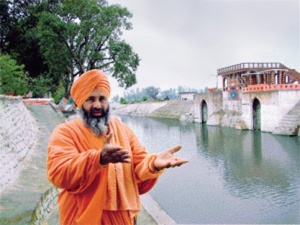Kali Bein: Difference between revisions
Hari singh (talk | contribs) No edit summary |
Allenwalla (talk | contribs) (added current news story) |
||
| Line 1: | Line 1: | ||
[[Image:Kalibeinsabarwahl A.jpg|thumb|right|300px|[[Sant Sancherwal]] alongside the now beautiful Kali Bein]] | [[Image:Kalibeinsabarwahl A.jpg|thumb|right|300px|[[Sant Sancherwal]] alongside the now beautiful Kali Bein]] | ||
'''Kali Bein''' is one of the important rivulets in [[Punjab]], [[India]]. With a length of 160 km, it emerges from a spring near [[Hoshiarpur]], flows through [[Kapurthala]] and [[Sultanpur Lodhi]], to meet the [[Sutlej]] near Harike Pattan. | The '''Kali Bein''' is one of the important rivulets in [[Punjab]], [[India]]. With a length of 160 km, it emerges from a spring near [[Hoshiarpur]], flows through [[Kapurthala]] and [[Sultanpur Lodhi]], to meet the [[Sutlej]] near Harike Pattan. | ||
The first Guru of Sikhs, [[Guru Nanak Dev]] used to take dip in the stream. During all religious occasions, the people of Punjab will dunk in this | The first Guru of the Sikhs, [[Guru Nanak Dev]] used to take a dip in the stream. During all religious occasions, the people of Punjab will dunk in this rivulet for purification. It is believed that Guru Nanak Dev had begun his holy march to deliver the word of God, from the river's bank. | ||
The 6 | The 6 year long efforts of [[Sant Balbir Singh Sancherwal]] which started in July 2000 has revived the river that had been neglected and misused. In the reign of Akbar the river was brick lined and the Gurdwara at Sultanpur Lodhi stands on its banks. | ||
Yet in 2000, it had become filled with sewage, as villages and towns had been dumping their waste along with a railway factory in Kapurthala, that used the rivulet to despise of its effluents. Weeds and debris made it a cesspool. That’s when Sant Balbir Singh Sancherwal jumped in and began cleaning it single handedly. His [[Seva]] soon to awaken the people, as his narrations of history, drew hundreds of followers to the task. | |||
Today, the river’s banks have been raised, inflows of waste, plugged, the river-bed desilted and flowering plants now line its length. | |||
The Kali Bein is once again clear and it flows! UNI reports that, in the next few months President Kalam is to visit the river to honour Sant Sancherwal. | |||
==2011, Kali Bein drying up== | |||
JALANDHAR: The [[SGPC]] and the [[Akal Takht]] on Wednesday demanded that the Punjab government release fresh water into the Kali Bein to save it. | |||
Not only had he stopped the flow of fresh water into the historic bin, but BJP MLA Amarjit Sahi had allegedly even questioned the religious and historical significance of the rivulet. | |||
http://timesofindia.indiatimes.com/india/Akal-Takht-SGPC-want-fresh-flow/articleshow/7977838.cms | |||
==See also== | ==See also== | ||
Latest revision as of 03:38, 14 April 2011

The Kali Bein is one of the important rivulets in Punjab, India. With a length of 160 km, it emerges from a spring near Hoshiarpur, flows through Kapurthala and Sultanpur Lodhi, to meet the Sutlej near Harike Pattan.
The first Guru of the Sikhs, Guru Nanak Dev used to take a dip in the stream. During all religious occasions, the people of Punjab will dunk in this rivulet for purification. It is believed that Guru Nanak Dev had begun his holy march to deliver the word of God, from the river's bank.
The 6 year long efforts of Sant Balbir Singh Sancherwal which started in July 2000 has revived the river that had been neglected and misused. In the reign of Akbar the river was brick lined and the Gurdwara at Sultanpur Lodhi stands on its banks.
Yet in 2000, it had become filled with sewage, as villages and towns had been dumping their waste along with a railway factory in Kapurthala, that used the rivulet to despise of its effluents. Weeds and debris made it a cesspool. That’s when Sant Balbir Singh Sancherwal jumped in and began cleaning it single handedly. His Seva soon to awaken the people, as his narrations of history, drew hundreds of followers to the task.
Today, the river’s banks have been raised, inflows of waste, plugged, the river-bed desilted and flowering plants now line its length.
The Kali Bein is once again clear and it flows! UNI reports that, in the next few months President Kalam is to visit the river to honour Sant Sancherwal.
2011, Kali Bein drying up
JALANDHAR: The SGPC and the Akal Takht on Wednesday demanded that the Punjab government release fresh water into the Kali Bein to save it.
Not only had he stopped the flow of fresh water into the historic bin, but BJP MLA Amarjit Sahi had allegedly even questioned the religious and historical significance of the rivulet.
http://timesofindia.indiatimes.com/india/Akal-Takht-SGPC-want-fresh-flow/articleshow/7977838.cms
See also
- See Wikipedia article on Kali Bein for more information
